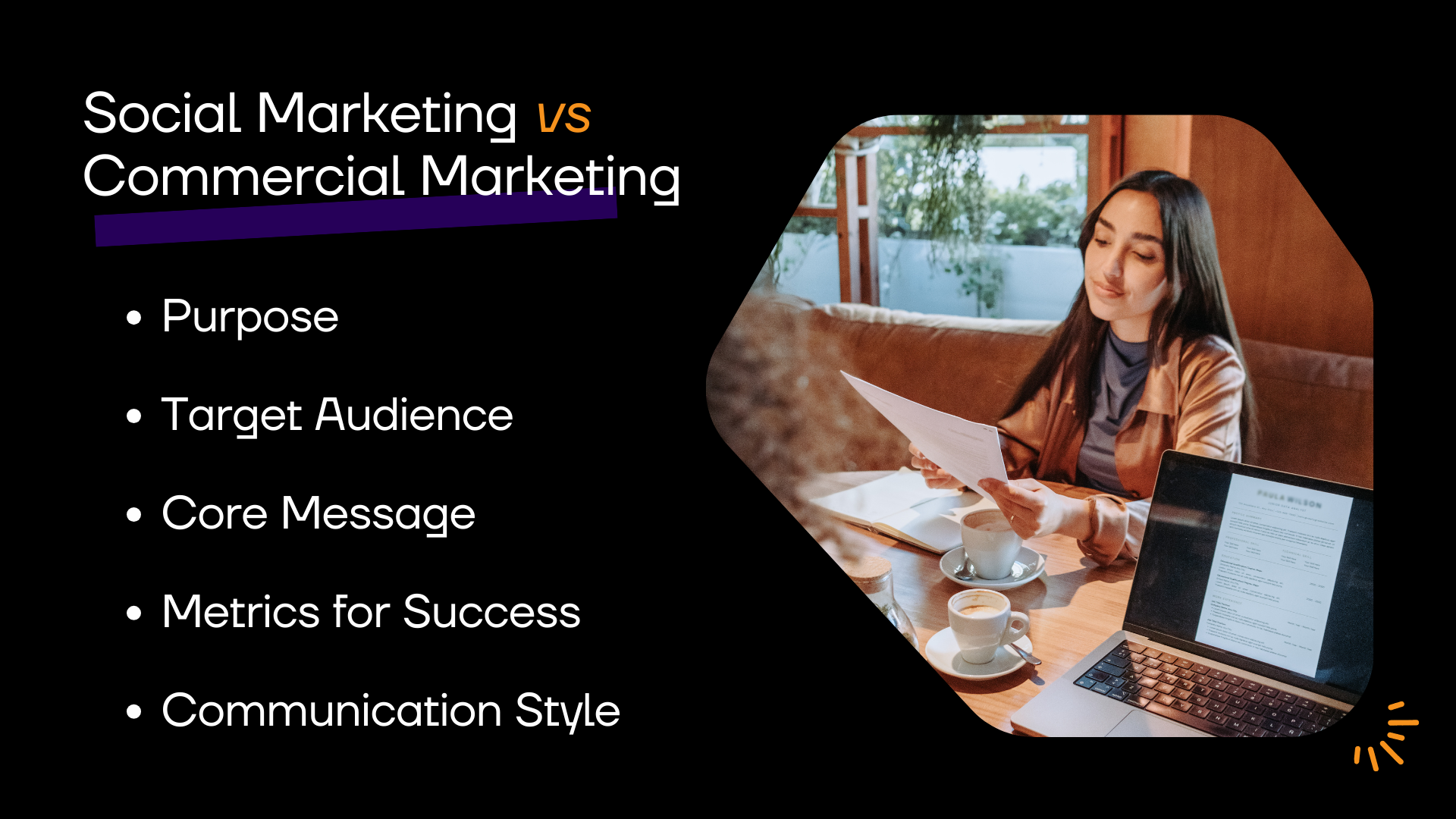Exploring the Distinctions: Social Marketing vs Commercial Marketing
Marketing is now an important component in forming society standards, impacting behavior, and pushing companies ahead, and it is not only a tool for product sales.
Two main marketing branches dominate this dynamic area. Using marketing concepts, social marketing inspires good behavior for the benefit of society by supporting environmentally friendly lifestyles or the betterment of health. Commercial marketing, on the other hand, prioritizes profitability, brand recognition, and market share.
We will review the fundamental ideas of social marketing vs commercial marketing, contrast their differences, and investigate their overlapping methods, roles, and effects.
What is Social Marketing?
Social marketing aims to change people’s and society’s behavior. The ultimate objective is to drive constructive change, often addressing societal issues including public health, environmental preservation, and safety.
Key Objectives:
-
Promoting Social Causes: Publicizing and supporting social problems.
- Behavior Change: Promoting behavior such as recycling, working out, or giving up smoking.
-
Raising Public Awareness: Public education on climate change and mental health.
Unique Characteristics:
- Focus on Public Interest: Social marketing’s main objective is to promote the greater good. It promotes socially beneficial actions and ideas.
- Behavior Change Strategies: Social marketers use incentives, social proof, and persuasive messaging among other tactics to inspire desired behavior.
- Targeted Audiences: Young adults, parents, and low-income areas are commonly targeted by social marketing.
-
Long-Term Impact: Social marketing seeks long-term behavioral changes instead of transient outcomes. Multifaceted campaigns tend to take time to produce results.
 What is Commercial Marketing?
What is Commercial Marketing?
While satisfying consumer requirements and expectations, commercial marketing is mostly concerned with selling products and services to make revenue. It requires knowing the target audience, their tastes, and how to attract and retain them. Commercial marketing seeks to create devoted markets, improve brand awareness, and propel steady corporate development by using market research, advertising, and promotional efforts. Its ultimate purpose is to build customer and business value for long-term success in competitive marketplaces.
Key Objectives:
-
Driving Revenue: Driven mostly by raising profits and sales.
- Building Brand Awareness: Boosting brand awareness and trust.
- Expanding Market Share: Capturing new customer segments.
-
Enhancing Consumer Satisfaction: Satisfying consumer expectations for quality and value.
Unique Characteristics:
-
Profit Orientation: Commercial Marketing aims to make money for the company, unlike Social Marketing.
- Competitive Nature: Businesses vie in commercial markets for brand loyalty and market share.
- Use of Traditional Marketing Strategies: Advertising, sales promotions, and PR are common commercial marketing methods.
-
Short-Term Impact: Usually, the effectiveness of a commercial marketing campaign is measured by quick effects like brand awareness or sales.
Social Marketing vs Commercial Marketing: Key Differences
| Factor | Social Marketing | Commercial Marketing |
| Purpose | Behavior change, societal benefits. | Profit generation, consumer satisfaction. |
| Target Audience | Communities, policymakers, and the general public. | Consumers and business segments. |
| Core Message | Focus on values, education, and awareness. | Focus on product benefits and value. |
| Metrics for Success | Social impact, behavior adoption rates. | Sales growth, market share, ROI. |
| Communication Style | Educational and informative. | Persuasive and promotional. |
Social and commercial marketing have different goals, audiences, and methods. Social marketing mostly aims to inspire changes in behavior that would help people and society at large, like better public health or support of environmental sustainability. Social influence and adoption of target population behavior determine social marketing success.
Conversely, commercial marketing aims to satisfy existing customers’ requirements by advertising goods, services, or brands thereby generating profit. Here the communication strategies are convincing and meant to emphasize the value and advantages of the products. Commercial marketing efforts are evaluated by revenue growth, market share, and ROI. Although both kinds of marketing entail changing behavior, their main goals and strategies differ greatly.
 Understanding the Parallels: Commercial Marketing vs Social Marketing
Understanding the Parallels: Commercial Marketing vs Social Marketing
Though they have different purposes, both methods have fundamental basic concepts and strategies in mind: the need for teamwork, effective communication, and the need for clearly defined, quantifiable goals to propel achievement.
- Shared Tools & Strategies: Both achieve their goals through advertising, branding, and well-planned campaigns. These instruments — which range from striking images to catchy slogans to creative ideas — help to leave a lasting impact on the audience and inspire intended actions.
- Target Audience Insights: Understanding audience preferences, behaviors, and demands is crucial for both. These insights from surveys, data analysis, and market research help guarantee that communications are relevant, engaging, and impactful, reaching the appropriate individuals at the right time.
- Outcome Measurement: Campaign evaluation of success depends critically on data. Click-through rates, conversions, and audience engagement are examined to optimize strategies and meet targets, enabling ongoing development.
- Storytelling: Both depend mostly on the capacity to create a compelling narrative. Strong stories provoke emotions, connections, and action. Stories may humanize companies, build empathy, or place a cause in a way that inspires people to act or remain devoted.
- Multi-Platform Promotion: Marketing now uses various channels to reach more people thanks to digital and social media. Both methods use television, radio, print, and social media to engage people and leave a lasting impression.
Commercial marketing vs social marketing have different goals, yet they both emphasize the necessity of communication and audience understanding. Both types of marketing shape behavior and advance society and the economy. So, marketers must grasp the contrasts and similarities between the two to build effective campaigns that produce social impact and financial success.
Why the Distinction Matters
Stakeholders must understand Social Marketing and Commercial Marketing to define strategies, goals, and outcomes.
- For Marketers: Knowing the distinction helps marketers’ campaign customization. It defines campaign objectives, audience engagement techniques, and brand messaging.
- For Organizations: Differentiating between the two helps firms align strategies with their goals. Profit-driven companies may prioritize customer acquisition and sales growth in commercial marketing. However, nonprofits and socially conscious corporations can use social marketing to make a difference. Some companies utilize a marketing mix.
- For Society: These distinctions show how marketing affects habits and behaviors.
Understanding these objectives ensures ads are real, impactful, and successful, whether they are promoting a new fashion line, climate change awareness, or a more sustainable lifestyle.
Conclusion
Social marketing promotes public health and environmental awareness. Commercial marketing seeks to profitably meet customer needs. Despite different goals and execution, both use advanced marketing methods to succeed.
Both social marketing vs commercial marketing are important for modern society; one advances the country while the other stimulates business. Current society relies on commerce for economic stability and prosperity, while progress drives innovation to solve today’s problems. Combining the goals of these two strategies can motivate significant change while still producing favorable financial results as companies become more environmentally sensitive. Corporate Social Responsibility projects, for instance, frequently combine the two and use marketing to generate profits while tackling social issues including inequality, climate change, or community development. Businesses can win while helping others by implementing ethical practices.


